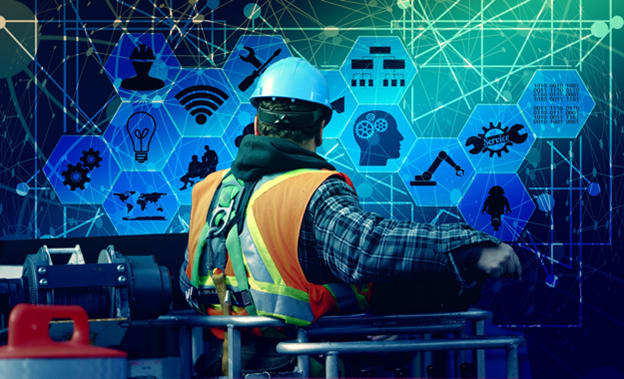Learn about the differences between information technology (IT) and operational technology (OT) and the benefits and challenges elicited by the prevailing trend towards IT/OT convergence.
Gary Guess, Product Portfolio Manager, RS, part of RS Group
Information Technology
Information technology (IT) includes the computing, networking and storage technologies used to generate, collect, store, manipulate, analyze and deliver data within and between organizations. A core characteristic of IT is its ability to be programmed and reprogrammed to satisfy the needs of users, applications and networks. Examples include both hardware, such as computers and networking equipment (e.g., switches, routers, firewalls, servers, storage arrays and backup devices), and software ranging from programs like spreadsheets and databases to operating systems and enterprise resource planning (ERP), business intelligence (BI), customer relationship management (CRM) and manufacturing execution systems (MES).
Operational Technology
Operational technology (OT) includes computing, networking and storage technologies used to monitor, process and relay information about and control physical processes in industrial workflows. OT is also comprised of hardware and software solutions but, unlike the virtually limitless possibilities offered by programmable IT, OT is often designed to execute a specific task, such as monitor mechanical performance, control heat or trigger emergency shutoffs. Examples of OT range from simple location tracking sensors to programmable logic controllers (PLCs), distributed control systems (DCS), computer numerical control (CNC) systems, building automation systems (BAS) and complex industrial control systems (ICS) including the supervisory control and data acquisition (SCADA) systems used to collect, analyze and visualize industrial equipment data — such as temperature, vibration and power usage — to regulate equipment in ways designed to maintain peak operation and efficiency and minimize downtime. For instance, OT can control the how much electricity is being stored in a battery, the amount of liquid pumped through a pumping system and the speed at which HVAC fans spin.
IT vs. OT
The main difference between IT and OT is how the technology is used. The primary objective for IT is collecting and analyzing information to generate awareness or regulate business processes, while the primary objective for OT is collecting and employing information to control the physical processes executed by equipment and machinery. Another difference is that IT systems are typically able to perform essential operations within programmed functions without much human intervention, while OT has traditionally required manual operation, like flipping a switch, pulling a lever or pressing a button. In addition, IT has historically been associated with office buildings while OT has been associated with factories, warehouses and other industrial locations.
The challenges that IT and OT purchasers, installers and operators face differ in some ways as well. Common IT challenges include ensuring interoperability, maintaining equipment and protecting equipment like IoT technologies from cybersecurity threats. OT purchasers, installers and operators face these same challenges but, due to the closed nature of many OT systems, like power grids, haven’t historically had to contend with as many cybersecurity threats.

The crux of the differences between IT and OT is that they evolved from different sources. IT evolved from early mainframe computers, PCs and file servers, while OT evolved from the first digital control technologies designed to be directly integrated into machinery, like PLCs, and as such, wasn’t designed to integrate with IT.
However, as IT and OT have continued to evolve — capitalizing on more powerful computing capabilities, improved storage systems, superior networking technologies and the development of new IoT, artificial intelligence (AI) and machine learning technologies — they have also begun to converge, sharing more and more data to apply the intelligence of IT systems to the physical assets of OT systems to achieve new efficiencies. For example, traditional temperature controls installed in OT systems provided closed-loop reports that had to be read and responded to by employees on the factory floor, while IoT-enabled temperature sensors installed in OT systems communicate in real-time with other facility assets capable of responding to the information and making automatic adjustments to achieve maximum performance. However, as more and more physical assets are brought online, OT’s susceptibility to cybersecurity threats rises.
IT/OT Convergence

The historic differences between IT and OT are quickly dissolving and giving way to increased interconnectivity that dramatically enhances the value that these systems deliver. In fact, IT/OT convergence is a key driver of Industry 4.0 and industrial IoT (IIoT) technologies and an essential component of smarter factories, warehouses, energy grids, buildings and supply chains. For example, IT/OT convergence enables facility managers to collect, manipulate and analyze OT system data and then use that data to generate IT insights aimed at streamlining operations, increasing efficiencies, fostering innovation and introducing new services. IT/OT convergence also allows facility managers to use IT system data to update and optimize OT systems, enabling them to perform their physical operations better, faster and more efficiently.
IIoT infrastructure is a critical requirement for any IT/OT convergence strategy.
These technologies include edge devices, wireless networks, cloud application programming interfaces (APIs) and distributed IIoT applications and are responsible for collecting, transmitting and processing IT and OT system data. Edge devices glean data from industrial equipment and then filter, prioritize and otherwise process OT data, wireless networks send this data to the cloud and then cloud APIs integrate this data into cloud-based IT systems. Distributed IIoT applications are built on a cloud IoT platform but run on both edge devices and in the cloud so they can communicate and coordinate with IIoT infrastructure in real-time, telling IT and OT systems when and how operators want the system data collected, transmitted and processed.
Common IT/OT convergence applications include real-time remote asset tracking, monitoring and troubleshooting, predictive maintenance and equipment-as-a-service (EaaS). In real-time remote asset tracking, monitoring and troubleshooting applications, IT/OT convergence allows operators to see where a particular asset (e.g., a vehicle, tool or machine) is located and when it will arrive at its destination as well as to find out what an asset is doing and affect its operation. In predictive maintenance applications, IT/OT convergence allows operators to collect data that can be used to determine when an asset is likely to require maintenance and then perform that maintenance to avoid unplanned equipment downtime and reduce maintenance costs. In EaaS applications, IT/OT convergence allows original equipment manufacturers (OEMs) to offer a usage-based payment structure rather than requiring customers to purchase the asset outright, which allows customers to avoid high upfront equipment costs and provides OEMs with predictable long-term revenue streams.
IT/OT Convergence Benefits
The evolution of powerful computing capabilities, storage systems and networking technologies, the proliferation of IoT, IIoT, AI and machine learning technologies and the rise of Industry 4.0 have brought IT/OT convergence into the mainstream. And while many companies are still in the beginning stages of implementing IIoT equipment and developing an IT/OT convergence strategy, the benefits of IT/OT convergence are already becoming clear. The most impactful benefits of IT/OT convergence include optimizing processes, mitigating machine downtime and maintenance costs, generating new service offerings and revenue streams and encouraging innovation.
- Optimizing Processes: Companies that implement IIoT technologies and IT/OT convergence strategies can use system data to increase efficiencies and streamline, automate and otherwise optimize business and physical processes. For example, by collecting OT system data about a particular motor’s energy usage, an IT system can regulate the motor’s operation to increase its energy efficiency
- Mitigating Machine Downtime and Maintenance Costs: Using IIoT devices to collect OT data and IT systems to analyze that data allows operators to enact predictive maintenance strategies rather than preventative and reactive maintenance strategies, which drastically reduce machine downtime and maintenance costs. In some cases, IT/OT convergence systems can even enable operators to conduct maintenance work remotely.
- Generating New Service Offerings and Revenue Streams: IT/OT convergence can also allow OEMs to shift from the selling equipment to selling EaaS, which eliminates high upfront equipment costs for customers and provides OEMs with predictable long-term revenue streams.
- Encouraging Innovation: In addition, EaaS products equipped with IT/OT convergence systems can provide OEMs with valuable insights into how customers actually use their equipment, which can spur innovations aimed at improving both their value proposition and their bottom line.
IT/OT Convergence Challenges

The challenges faced by IT and OT purchasers, installers and operators include ensuring interoperability, maintaining equipment and protecting equipment like IoT technologies from cybersecurity threats. Due to the traditionally closed nature of many OT systems, IT systems have long been significantly more susceptible to cybersecurity threats. However, now that IoT and IIoT devices are increasingly connecting physical assets to the internet as well, cybersecurity threats also pose a serious risk to OT systems. Most IoT and IIoT devices are always online, providing bad actors with multiple points of entry with around-the-click potential.
This increased risk to OT systems combined with the trend towards IT/OT convergence has personnel including chief information officers (CIOs), chief information security officers (CISOs) and IT departments collaborating to design systems and networks that can provide robust, effective protection for every connection in both IT and OT systems.
In addition to cybersecurity challenges, companies interested in IT/OT convergence often run into challenges when trying to connect their IT systems to their OT systems. Obstacles in this department can include connectivity issues, data collection problems, cloud integration complications and application scaling and updating issues. For instance, using IT edge devices to collect data from OT systems can be challenging because OT equipment often uses different communications protocols than the edge devices. Some installers and operators also find it difficult to connect edge devices to secure wireless networks and to optimize those connections for energy efficiency and data transfer. Developing or sourcing the APIs needed to integrate OT data in cloud-based IT systems is another common challenge, as are scaling local or proof of concept IIoT applications to include new assets or locations and keeping IIoT applications up to date as operation demands evolve.
One thing that all of these challenges have in common is the complexity involved in purchasing, building and maintaining the robust IIoT infrastructure required to support effective IT/OT convergence. Companies committed to getting it right should seek input from experts in the embedded device firmware, wireless connectivity, IT/OT convergence security and cloud application development industries.
IT/OT Convergence Assistance
RS offers an extensive suite of industrial networking solutions from industry-leading suppliers including Advantach, Hirschmann, Moxa, Phoenix Contact, Red Lion and RS Pro as well as a team of highly trained experts ready to assist you with your IT/OT convergence strategy. Stocked solutions range from essentials including Ethernet switches, IoT edge gateways, media converters, routers and wireless communication devices to servers, cameras, panel meters, PLCs, HMI displays, Ethernet and network cables, data, Ethernet and telecom connectors, industrial cable assemblies, protocol converters and software.
For assistance identifying industrial networking solutions optimized for your unique applications, contact your local RS representative at 1.866.433.5722 or reach out to RS’s technical support team.







